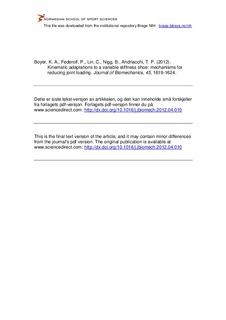| dc.contributor.author | Boyer, K. | |
| dc.contributor.author | Federolf, Peter | |
| dc.contributor.author | Lin, C. | |
| dc.contributor.author | Nigg, Benno | |
| dc.contributor.author | Andriacchi, T. P. | |
| dc.date.accessioned | 2013-01-03T09:25:32Z | |
| dc.date.available | 2013-01-03T09:25:32Z | |
| dc.date.issued | 2012 | |
| dc.identifier | Seksjon for fysisk prestasjonsevne / Department of Physical Performance | |
| dc.identifier.citation | Journal of Biomechanics. 2012, 45(9), 1619-1624 | no_NO |
| dc.identifier.issn | 0021-9290 | |
| dc.identifier.uri | http://hdl.handle.net/11250/171092 | |
| dc.description | I Brage finner du siste tekst-versjon av artikkelen, og den kan inneholde ubetydelige forskjeller fra forlagets pdf-versjon. Forlagets pdf-versjon finner du på www.sciencedirect.com: http://dx.doi.org/10.1016/j.jbiomech.2012.04.010 / In Brage you'll find the final text version of the article, and it may contain insignificant differences from the journal's pdf version. The definitive version is available at www.sciencedirect.com: http://dx.doi.org/10.1016/j.jbiomech.2012.04.010 | no_NO |
| dc.description.abstract | A recently described variable-stiffness shoe has been shown to reduce the adduction moment and pain in patients with medial-compartment knee osteoarthritis. The mechanism associated with how this device modifies overall gait patterns to reduce the adduction moment is not well understood. Yet this information is important for applying load modifying intervention for the treatment of knee osteoarthritis.
A principal component analysis (PCA) was used to test the hypothesis that there are differences in the frontal plane kinematics that are correlated with differences in the ground reaction forces (GRFs) and center of pressure (COP) for a variable-stiffness compared to a constant-stiffness control shoe. Eleven healthy adults were tested in a constant-stiffness control shoe and a variable-stiffness shoe while walking at self-selected speeds. The PCA was performed on trial vectors consisting of all kinematic, GRF and COP data.
The projection of trial vectors onto the linear combination of four PCs showed there were significant differences between shoes. The interpretation of the PCs indicated an increase in the ankle eversion, knee abduction and adduction, decreases in the hip adduction and pelvic obliquity angles and reduced excursion of both the COP and peak medial–lateral GRFs for the variable-stiffness compared to the control shoe.
The variable-stiffness shoe produced a unique dynamic change in the frontal plane motion of the ankle, hip and pelvis that contributed to changes in the GRF and COP and thus reduced the adduction moment at a critical instant during gait suggesting a different mechanism that was seen with fixed interventions (e.g. wedges). | no_NO |
| dc.language.iso | eng | no_NO |
| dc.publisher | Elsevier | no_NO |
| dc.subject | variable-stiffness shoe | no_NO |
| dc.subject | kinematics | no_NO |
| dc.subject | osteoarthritis | no_NO |
| dc.subject | walking | no_NO |
| dc.subject | knee adduction moment | no_NO |
| dc.title | Kinematic adaptations to a variable stiffness shoe: mechanisms for reducing joint loading | no_NO |
| dc.type | Journal article | no_NO |
| dc.type | Peer reviewed | no_NO |
| dc.subject.nsi | VDP::Technology: 500 | no_NO |
| dc.source.pagenumber | 1619-1624 | no_NO |
| dc.source.volume | 45 | no_NO |
| dc.source.journal | Journal of Biomechanics | no_NO |
| dc.source.issue | 9 | no_NO |
